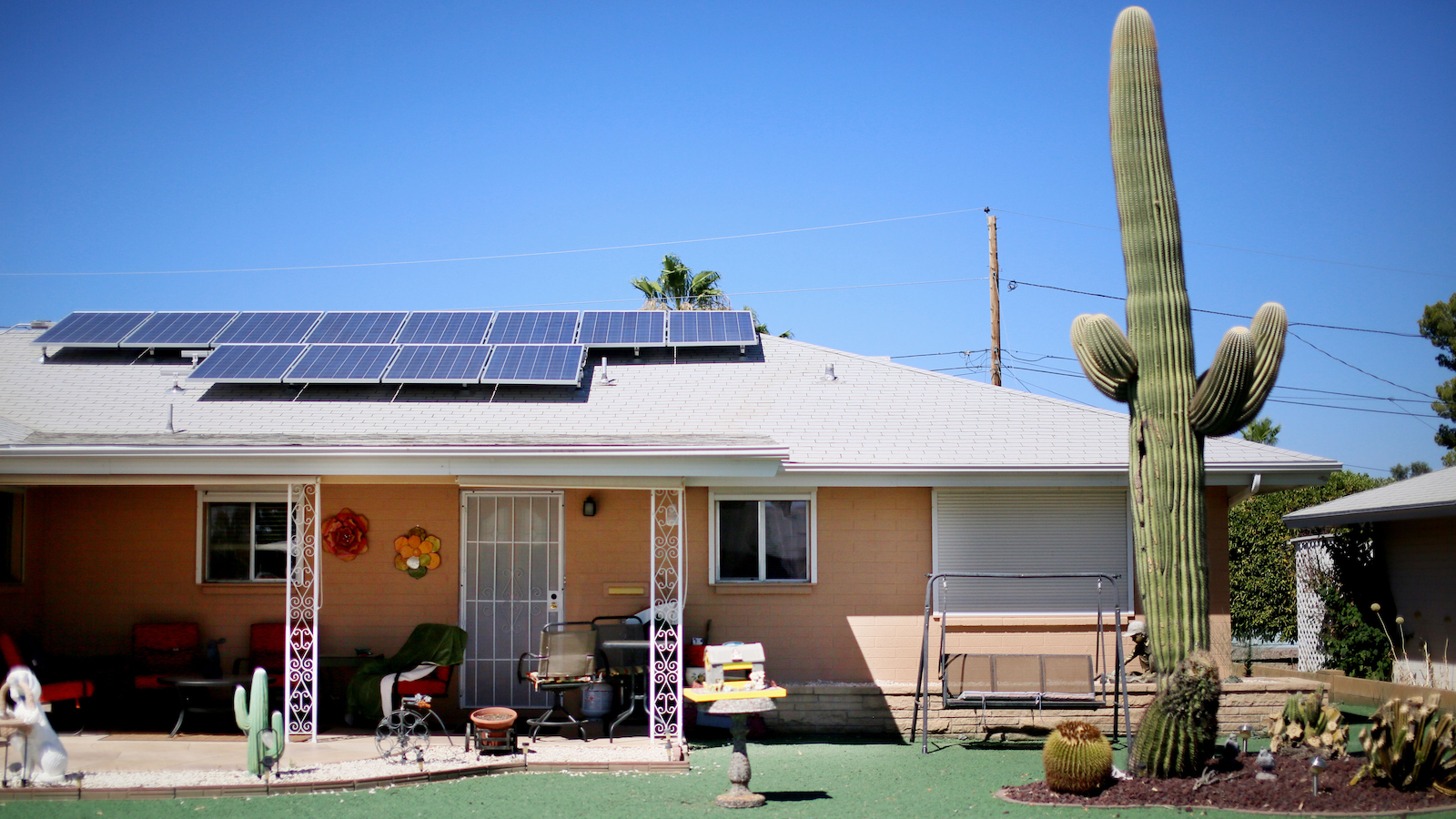In 2015, the rooftop solar industry in Maricopa County, Arizona, dried up almost overnight. That year, the Salt River Project, or SRP, a state-owned electric utility that serves about 2 million customers in the Phoenix metropolitan area, set new rates for rooftop solar owners. Suddenly, generating your own electricity from the sun was expected to cost you $600 more per year on your electric bill than it had the year before. At that rate, paying off the panels could take twice as long.
For anyone following the current battle over rooftop solar in California, the rationale for the change will sound familiar. As more of SRP’s customers started generating their own electricity with rooftop solar, the utility’s revenue declined. It claimed that as a result, the cost of maintaining the electric grid would be shifted onto non-solar customers.
But SRP’s solution of raising rates for solar customers led rooftop solar installations to drop by up to 95 percent between 2014 and 2015. Solar companies, as well as everyday people with an interest in rooftop solar, were outraged. In 2019, a group of citizens decided to take SRP to court for “engaging in anticompetitive conduct” and discriminating against solar customers.
A federal district court dismissed the case, finding that the plaintiffs did not prove that they had suffered antitrust injury. But earlier this month, the 9th U.S. Circuit Court of Appeals rejected that finding and remanded the case back to the lower court. Perhaps more importantly, the 9th Circuit confirmed that SRP is not immune to antitrust challenges.
Jean Su, a senior attorney at the Center for Biological Diversity, believes the case could crack open the door to using antitrust law to rein in widespread attacks on clean energy by utilities around the country. “The original intention of antitrust law was to question when corporations got too big and when they had disproportionate influence over the government and over politicians,” she said, “and I think that’s what we are seeing right now.”
Why utilities are typically protected from antitrust
Utilities have long been considered to be protected against antitrust laws. In most of the U.S., electricity is delivered by private companies that are granted monopoly control over a given area in exchange for providing reliable power to everyone who wants it at the lowest cost. This setup emerged in the early 20th century to serve the public interest by allowing electricity companies to achieve economies of scale and rapidly expand access to electricity.
There are some checks and balances built into the system. Private utilities are typically regulated by state commissions that are supposed to ensure that their service is adequate and their rates are “just and reasonable.” About 28 percent of Americans are served by publicly owned power companies managed by city-appointed officials or democratically elected boards. But these checks aren’t designed to take climate goals into account. On top of that, regulatory capture is common, with investor-owned utilities using dark money to get industry-friendly voices on state commissions and in public office.
With regulatory and legislative support, some utilities have been suppressing competition from the solar industry for years. The largest electric utility in Alabama has been charging rooftop solar customers a $20 to $32 monthly fee since 2013. Just last week, a Michigan utility proposed charging solar customers fees that could amount to $100 or more per month. Several states have caps on how many rooftop solar systems can qualify for net-metering, the accounting system that allows customers to earn credits on their bills for the electricity they produce and don’t use. In many states, utilities have lobbied legislatures to weaken or end net-metering.
Joe Smyth, a researcher at the utility watchdog organization the Energy and Policy Institute, told Grist that these tactics are not limited to investor-owned utilities, naming cooperatively owned companies in Tennessee, Kentucky, Colorado, and New Mexico that have proposed fees for customers who add rooftop solar. He added that many public utilities are exempt from state policies that mandate net-metering.
To Su, the whole premise of granting monopoly power to a utility is undermined by the climate crisis. “One hundred years ago, it was a democratization of electricity,” she said. “Fast forward 100 years later: If you have utilities who are actually hurting the public interest when they attack clean energy alternatives, is this system working anymore?”
The court’s findings
The 9th Circuit’s decision rested on two main findings. First, SRP tried to argue that it is protected by the “filed-rate doctrine,” which says that if a company has filed its rates with a regulator who finds them to be just and reasonable, it can’t be sued by customers for violating antitrust law. However, as a state-owned entity, SRP does not file rates anywhere except with its own board. That’s the case for many public utilities, but SRP’s board isn’t even democratically elected: Due to a historical quirk, the only people who get to vote in SRP board elections are customers who own land, and their votes are weighted by how much land they own. SRP argued that filed-rate doctrine still holds because the Arizona legislature deems it fit to approve its own rates. The court disagreed.
Shelley Welton, an associate professor at the University of South Carolina School of Law, said that the court’s opinion on filed-rate doctrine may open up opportunities for customers to challenge rooftop solar fees at cooperatives, municipal utilities, and public power districts, though it won’t affect investor-owned utilities.
The second finding was that SRP is not entitled to “state-action immunity,” which says that states are allowed to act in ways that have anti-competitive effects if they are clearly authorized to do so by state law. In this case, the court pointed to statutes on Arizona’s books that explicitly seek to promote competition in the electricity market.
That finding was almost immediately at risk of reversal. An SRP-backed bill in the Arizona legislature this session would have repealed the statutes that allow for electric retail competition, and potentially enabled other utilities to edge out rooftop solar. But the bill died on the House floor on Monday.
Ultimately, SRP’s new rates did not entirely kill the rooftop solar market in Maricopa County. The annual number of applications has slowly increased since its initial fall in 2015, in part because panels have gotten cheaper. One residential installer in Arizona told Grist that customers are able to make it work by installing smaller systems, which means they are seeing lower savings on their electric bills. Court Rich, an attorney specializing in energy and regulatory law in Arizona, said it’s instructive to look at rooftop solar applications in the jurisdiction of a neighboring utility called Arizona Public Service.
“These utilities are right across the street from each other with the same types of customers living in the same climate with the same values and the same weather,” he said in an email. “Yet while one utility has 15 percent of its customers with rooftop solar, the other has less than 5 percent. Don’t get me wrong, Arizona Public Service wishes its regulators would have let it get away with what SRP has done and killed the industry, but SRP is the one that got to do it, and the results are obvious and effective.”



